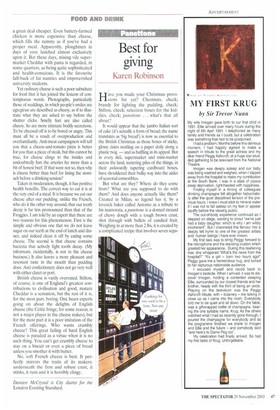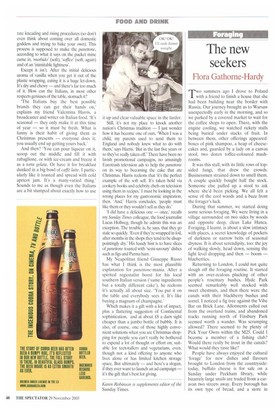Best for giving
Karen Robinson
Have you made your Christmas provisions list yet? Chestnuts, check; brandy for lighting the pudding, check; Stilton, check; selection boxes for the kiddies, check; panettone . . . what's that all about?
It would appear that the jumbo Italian sort of cake (it's actually a form of bread; the name translates as 'big bread') is now as essential to the British Christmas as those boxes of sticky, glossy dates nestling on a paper doily along a plastic twig — and as baffling in its appeal. But in every deli, supermarket and mini-market across the land, teetering piles of the things, in their awkwardly tapering cardboard boxes, have shouldered their bulky way into the aisles of seasonal comestibles.
But what are they? Where do they come from? What are you supposed to do with them? And does anyone actually like them? Created in Milan, so legend has it, by a lovesick baker called Antonio as a tribute to his inamorata, a panettone is a domed mound of chewy dough with a tough brown crust, shot through with bullets of candied fruit. Weighing in at more than 2 lbs, it is created by a complicated recipe that involves seven sepa
rate kneading and rising procedures (so don't even think about coming over all domestic goddess and trying to bake your own). This process is supposed to make the panettone, according to what it says on the packet mine came in, `morbido(soft), 'sofftce' (soft, again) and of an 'inimitable lightness'.
Except it isn't. After the initial delicious aroma of vanilla when you get it out of the plastic wrapping, eating it is a huge let-down. It's dry and chewy — and there's far too much of it. How can the Italians, in most other respects geniuses of the table, stomach it?
'The Italians buy the best possible brands they can get their hands on,' explains my friend Valentina Harris, a broadcaster and writer on Italian food. 'Ifs seasonal — they only make it at this time of year — so it must be fresh. What is funny is their habit of giving them as Christmas presents — everyone does it; you usually end up getting yours back.'
And then? 'You can pour liqueur on it, scoop out the middle and fill it with zabaglione, or with ice-cream and freeze it as a torta gelata. Or have it for breakfast dunked in a big bowl of caffe latte. I particularly like it toasted and spread with cold apricot jam. It's a many-varied thing.' Sounds to me as though even the Italians are a bit stumped about exactly how to use it up and clear valuable space in the larder.
Still, it's not my place to knock another nation's Christmas tradition — I just wonder how it has become one of ours. 'When I was a child, my parents used to send them to England and nobody knew what to do with them,' says Harris. 'But in the last five years or so they've really taken off.' There have been no lavish promotional campaigns, no amusingly Eurotrash television ads to help the panettone on its way to becoming the cake that ate Christmas. Harris reckons that It's the perfect example of the soft sell. It's taken hold via cookery books and celebrity chefs on television using them in recipes.' I must be looking in the wrong places for my gastronomic inspiration, then. 'And,' Harris concludes, 'people must like them or they wouldn't sell as they do.'
'I did have a delicious one — once,' recalls my Sunday Tunes colleague, the food journalist Lucas Hollweg, though he admits this was an exception. The trouble is, he says, that they go stale so quickly. 'Even if they're wrapped in foil, after months in the shops they tend to be disappointingly thy.' His handy hint is to have slices of panertone toasted with 'semi-savoury' dishes such as figs and Parma ham.
My Neapolitan friend Giuseppe Russo has what I think is the most plausible explanation for panettone-mania. After a spirited regionalist boost for his local southern Italian version ('same ingredients but a totally different cake'), he reckons it's actually all about size. 'You put it on the table and everybody sees it. It's like buying a magnum of champagne.'
Which makes it a gift with a lot of impact, plus a flattering suggestion of Continental sophistication, and at about £8 a dam sight cheaper than a jumbo bottle of bubbly. It is also, of course, one of those highly convenient solutions when you are Christmas shopping for people you can't really be bothered to expend a lot of thought or effort on; suitable for teetotallers and vegetarians, even, though not a kind offering to anyone who lives alone or has limited kitchen storage space. But ultimately — and here's a slogan, if they ever want to launch an ad campaign — it's the gift that's best for giving.
Karen Robinson is supplements editor of the Sunday Times.



























































































 Previous page
Previous page